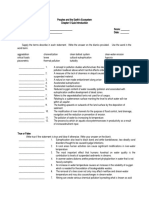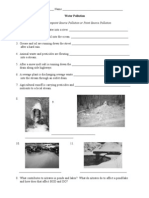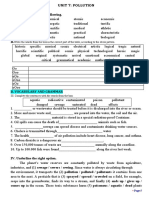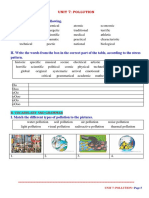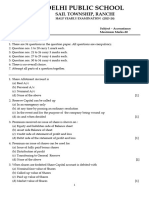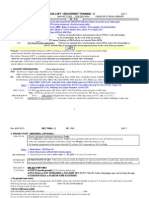Acid Rain Webquest 2023 PDF
Acid Rain Webquest 2023 PDF
Uploaded by
kateCopyright:
Available Formats
Acid Rain Webquest 2023 PDF
Acid Rain Webquest 2023 PDF
Uploaded by
kateOriginal Title
Copyright
Available Formats
Share this document
Did you find this document useful?
Is this content inappropriate?
Copyright:
Available Formats
Acid Rain Webquest 2023 PDF
Acid Rain Webquest 2023 PDF
Uploaded by
kateCopyright:
Available Formats
Acids and the Environment Webquest Name:
Go to http://www.epa.gov/acidrain to answer the following questions. You may need to click on other links within
the page to find the answers – surf around.
Acid Rain Basics What is Acid Rain?
1. Define acid rain or acid deposition:
Acid rain, or acid deposition, is a broad term that includes any form of precipitation with acidic components, such as
sulfuric or nitric acid that fall to the ground from the atmosphere in wet or dry forms. This can include rain, snow, fog, hail
or even dust that is acidic.
2.
What all types of precipitation does this include?
Rain
________________,
hair
________________, ________________, ________________, or even
snow fog
dust
________________.
What Causes Acid Rain?
3. a. What two compounds are the primary causes of acid rain?
5oz Sulfur dioxide
________________________
________________________
Nox oxides
Nitrogen
b. What are three major sources of most of those compounds?
__________________________________
burningof fossilfuels
_______________________________________
vehicles andheavy equipment
_______________________________________
oil refineries
manufacturing and
otherindustries
4. Discuss the pathway of acid rain in the environment – as described in the caption of the image.
1. Emissions of _______
502 and _______NO are released into the air
acid particles that may be transported long distances.
2. Pollutants are transformed into _______
3. These acid particles then fall to the earth as ________
wet and ________ deposition.
dry
soil
4. Causes harmful effects on ________, ______________,
forests ______________ and ____________.
streams lakes
Forms of Acid Deposition
5. What is wet deposition?
Wet deposition is what we most commonly think of as acid rain. The sulfuric and nitric
acids formed in the atmosphere fall to the ground mixed with rain, snow, fog, or hail.
6. What is dry deposition?
Acidic particles and gases can also deposit from the atmosphere in the absence of moisture as dry deposition.
The acidic particles and gases may deposit to surfaces (water bodies, vegetation, buildings) quickly or may
react during atmospheric transport to form larger particles that can be harmful to human health.
Measuring Acid Rain
PH
7. Acid rain is measured using the _____________ scale.
8. Even normal rain is acidic because of carbon dioxide
____________ __________ dissolved in it forming weak carbonic
5.6
acid, giving it a pH around ________.
4.2 4.4
9. Most acid rain falling on the US has a pH between ______-______.
10. What does the NADP and NTN do? How many monitoring sites do they have?
The NADP/NTN collects acid rain at more than 250 monitoring sites throughout the US,
Canada, Alaska, Hawaii and the US Virgin Islands.
11. What does the LTM (Long-term Monitoring Network) measure? How many sites do they monitor?
The Long-Term Monitoring (LTM) Network measures and monitors surface water chemistry at over 280
sites to provide valuable information on aquatic ecosystem health and how water bodies respond to
changes in acid-causing emissions and acid deposition.
Go back to the main page. Click on Acid Rain Basics Effects of Acid Rain
Effects of Acid Rain on Ecosystems
12. An ___________________
ecosystem is a community of plants, animals and other organisms along with their
environment including the air, water and soil.
13. The ecological effects of acid rain are most clearly seen in aquatic environments, such as streams
___________,
___________, and ___________,
lakes fish
marshes where it can be harmful to ______________ wildlife
and other ___________.
acid
14. The more ______________ that is introduced to the ecosystem (pH decreases), the more
aluminum is released.
_______________
15. What is the animal that is most tolerant of pH changes – that has a critical pH around 4? _____________
Frogs
Effects of Acid Rain on Plants and Trees
Aluminum
16. Acid rain leaches __________________ from the soil. That aluminum may be harmful to ____________ as
Plantsfrom the
well as _____________.
animals Acid rain also removes __________________
minerals and __________________
nutrients
soil that trees need to grow.
17. What effect does acidic fog have on plants/trees?
At high elevations, acidic fog and clouds might strip nutrients from trees’ foliage, leaving them with brown or dead leaves and
needles. The trees are then less able to absorb sunlight, which makes them weak and less able to withstand freezing temperatures.
Buffering Capacity
18. Many forests, streams, and lakes that experience acid rain don’t suffer effects because the soil in those
areas can _______________ the acid rain by _____________________ the acidity in the rainwater flowing
buffer neutralizing
through it. This capacity depends on the ___________________
thickness and __________________
composition of the soil and
the type of bedrock underneath it.
Episodic Acidification
19. Melting snow and heavy rain downpours can result in what is known as episodic acidification. This short
duration of __________ _______________
acidity (i.e., lower pH) can result in a short-term stress on the
higher
injured killed
ecosystem where a variety of organisms or species may be _____________ or ________________.
Nitrogen Pollution
20. It’s not just the acidity of acid rain that can cause problems. Acid rain also contains _______________, and
Nitrogen
this can have an impact on some ecosystems. For example, nitrogen pollution in our coastal waters is
fish
partially responsible for declining __________________ and ________________
shellfish populations in some
human
areas. In addition to agriculture and wastewater, much of the nitrogen produced by ____________
activity
______________ that reaches coastal waters comes from the ________________________.
atmosphere
Effects of Acid Rain on Materials
21. Describe the effects of dry deposition on…
a. Metals corrode
b. Paint/stone deteriorate
c. Buildings
dirty tee surface
Effects of Acid Rain: Human Health
22. Can your health be affected, in a harmful way, by drinking, swimming in, or walking through acid rain?
In the atmosphere, SO2 and NOX gases can be transformed into sulfate and nitrate particles, while some NOX can also react with other pollutants to form ozone. These particles and
ozone make the air hazy and di cult to see through. This a ects our enjoyment of national parks that we visit for the scenic view such as Shenandoah and the Great Smoky Mountains.
23. When is it harmful?
Walking in acid rain, or even swimming in a lake a ected by acid rain, is no more dangerous to humans than walking in normal rain or swimming in non-acidic lakes. However,
when the pollutants that cause acid rain —SO2 and NOX, as well as sulfate and nitrate particles— are in the air, they can be harmful to humans.
heart
24. Many scientific studies have shown a relationship between these particles and effects on ___________
functions such as ___________
_____________,
heart ___________
attacks resulting in death for people with increased heart
function
disease risk, and effects on _________ ____________, such as breathing difficulties for people with
______________________.
asthma lung
Go back to the main page. Click on What EPA Is Doing Acid Rain Program
25. What is the overall goal of the ARP?
The ARP was the rst national cap and trade program in the country and it introduced a system of allowance trading that uses market-based
incentives to reduce pollution. Reducing emissions using a market-based system provides regulated sources with the exibility to select the most cost-
e ective approach to reduce emissions, and has proven to be a highly e ective way to achieve emission reductions, meet environmental goals, and
improve human health.
Read the Compound Chem article: Ocean Acidification: “The Other Carbon Dioxide Problem” and answer
the following questions. (http://www.compoundchem.com/2017/01/18/ocean-acidification-co2/)
26. What has caused the increase in atmospheric carbon dioxide?
burning of fossil fuelsanddeforestation
27. Ocean acidification occurs when atmospheric carbon dioxide dissolves in sea water and causes a
________________
decrease in the pH of seawater.
28. What was the pH of oceans in pre-industrial times?
8.2
29. In 2013?
8 I
30. What is the pH estimated to be in 2100?
7.7
31. The difference
ocean.
25
of 0.1 pH units means that there is a _____% increase of hydrogen ion concentration in the
carbon dioxide
32. Atmospheric ___________ ____________ dissolves in seawater and reacts with the water to form
carbonic
______________ acid
___________.
increase
33. Hydrogen ions produced by this dissociation ______________ acidity (lowering pH).
34. What are calcifying organisms, and how are they affected by ocean acidification?
Clams oysters crustaceans
Shells are being dissolved
35. How will this affect the food chain?
You might also like
- Scat ManualDocument8 pagesScat Manualumama yahya67% (6)
- Sodium Sulphate Production LineDocument19 pagesSodium Sulphate Production LineHamdael100% (2)
- Guided Notes - Cycles in Ecosystems 1Document6 pagesGuided Notes - Cycles in Ecosystems 1Yassine Koot33% (3)
- Acid Rain WebquestDocument2 pagesAcid Rain WebquestRYAN SCOTTNo ratings yet
- Air Pollution NotesDocument9 pagesAir Pollution NotesNatan BogaleNo ratings yet
- 6.4 Acid DepositionDocument6 pages6.4 Acid DepositionKabir KhatriNo ratings yet
- SULFURDocument2 pagesSULFURtugadegeraldine04No ratings yet
- 1.4.9 Pollution WorksheetDocument5 pages1.4.9 Pollution WorksheetSarah Etta100% (2)
- Changes in Our Environment Pws - 1,2Document8 pagesChanges in Our Environment Pws - 1,2Sweety RoseNo ratings yet
- 6.4 Acid Deposition: IB Environmental Systems and SocietiesDocument6 pages6.4 Acid Deposition: IB Environmental Systems and SocietiesDevanshi MehtaNo ratings yet
- Acid Rain WorksheetDocument1 pageAcid Rain WorksheetMaria CamilleriNo ratings yet
- People and Earth Ecosystem - Midterm - TestDocument3 pagesPeople and Earth Ecosystem - Midterm - TestMARIZA MAPALONo ratings yet
- Carbon Nitrogen Water CyclesDocument5 pagesCarbon Nitrogen Water Cyclestyuan0228No ratings yet
- Unit Test in BiodiversityDocument2 pagesUnit Test in BiodiversityRoziel MontalbanNo ratings yet
- Cycles WorksheetDocument4 pagesCycles Worksheetapi-329196870100% (2)
- Seatwork Chapter 5 - Impact To WaterDocument2 pagesSeatwork Chapter 5 - Impact To WaterChristopher EgeNo ratings yet
- Circle the underlined part that needs corectionDocument23 pagesCircle the underlined part that needs corectionhonglinh1102008No ratings yet
- Quiz 4 - Impact To SoilDocument2 pagesQuiz 4 - Impact To SoilJohn CenaNo ratings yet
- Power Content Reading 1Document5 pagesPower Content Reading 1Sabrina ObidovaNo ratings yet
- Unit 5 Global WarmingDocument19 pagesUnit 5 Global Warmingtuuyenluong2709No ratings yet
- 14 - Healthy SurroundingsDocument9 pages14 - Healthy SurroundingsRenu ThampiNo ratings yet
- Water Pollutant #1: PcbsDocument4 pagesWater Pollutant #1: PcbsBindu M PillaiNo ratings yet
- MC Science - Revision WS - Stage 6 - C04Document9 pagesMC Science - Revision WS - Stage 6 - C04juanitapakpahan27jpNo ratings yet
- Environmental PolutionDocument2 pagesEnvironmental PolutionVIPAN GUPTANo ratings yet
- Bottle Ecosystem Lab Tim Downs1Document4 pagesBottle Ecosystem Lab Tim Downs1api-259776843No ratings yet
- Assignments 1705810496902Document3 pagesAssignments 1705810496902kavyasampathkumar144No ratings yet
- Heat Transfer NotesDocument1 pageHeat Transfer NoteslshawNo ratings yet
- Week 1 - LS2 - Whats Happening Part 1Document2 pagesWeek 1 - LS2 - Whats Happening Part 1Fahmia Angkal SalilaguiaNo ratings yet
- People and Earth Ecosystem - MIDTERM SET BDocument3 pagesPeople and Earth Ecosystem - MIDTERM SET BMARIZA MAPALONo ratings yet
- Bo Tro Success Anh 10 FullDocument8 pagesBo Tro Success Anh 10 FullsjskimNo ratings yet
- Science 8 (Review Test) : NameDocument2 pagesScience 8 (Review Test) : NameJolly CharmzNo ratings yet
- Science P5 Revision Unit 11Document8 pagesScience P5 Revision Unit 11starsschooljktNo ratings yet
- INGLÉS Guia 7° Nov 2019Document5 pagesINGLÉS Guia 7° Nov 2019Paula Maluenda TorresNo ratings yet
- Science Worksheet Natural ResourcesDocument4 pagesScience Worksheet Natural Resourcessatrio.wibowoNo ratings yet
- Water: Vocabulary Worksheet - Unit 6Document3 pagesWater: Vocabulary Worksheet - Unit 6Ezzeddine Ben CheikhNo ratings yet
- Practice Sheet For Health Air 2019Document2 pagesPractice Sheet For Health Air 2019lannyNo ratings yet
- Biomes of Our EarthDocument5 pagesBiomes of Our Earthwangxiaoqi041208No ratings yet
- 06. Vocabulary B1Document1 page06. Vocabulary B1Marcos RebolloNo ratings yet
- Lesson 7 - Unit 3Document6 pagesLesson 7 - Unit 3Thùy Dương ĐoànNo ratings yet
- Midterm Exam Form 4 INTESCI COMPLETEDocument10 pagesMidterm Exam Form 4 INTESCI COMPLETECHRISTOPHER SCALENo ratings yet
- I.A. Read The Paragraphs Below and Match Them With The Threat They Refer ToDocument5 pagesI.A. Read The Paragraphs Below and Match Them With The Threat They Refer ToDayana Suarez Ramos100% (1)
- Environment - ExerciseDocument5 pagesEnvironment - ExercisedkjfdjNo ratings yet
- ReadingDocument3 pagesReadingEDWIN RICARDO BECERRA GODOYNo ratings yet
- Prelim Exam Introduction To Water Management and IrrigationDocument3 pagesPrelim Exam Introduction To Water Management and IrrigationRamos, Keith A.No ratings yet
- Kami Export - Dany Lopez Vail - WaterCycleSEDocument3 pagesKami Export - Dany Lopez Vail - WaterCycleSEDany Lopez VailNo ratings yet
- ESS 4.4-Water-PollutionDocument6 pagesESS 4.4-Water-PollutionAnika HinkovaNo ratings yet
- Activity 2 - L6 - Chemical Properties - Part IIDocument1 pageActivity 2 - L6 - Chemical Properties - Part IIkfrancisNo ratings yet
- 5.3 Science Exam 22 23 1Document2 pages5.3 Science Exam 22 23 1Juan Pablo ZamoraNo ratings yet
- Acid Rain ReadingDocument3 pagesAcid Rain Readingashley.deveroNo ratings yet
- Water ExerciseDocument3 pagesWater ExercisethebearablescarfaltaccNo ratings yet
- Science P1 Topic 1Document2 pagesScience P1 Topic 1jalapenoce.ocNo ratings yet
- Student Exploration: Water PollutionDocument5 pagesStudent Exploration: Water PollutionMartinaXu33% (3)
- E8 Unit 7Document73 pagesE8 Unit 7Фунг Тханх КуангNo ratings yet
- Science 7Document4 pagesScience 7April Rose Alforque MagbanuaNo ratings yet
- Kami Export - Biogeochemical - Cycles - Webquest1Document7 pagesKami Export - Biogeochemical - Cycles - Webquest1Ethan JohnsonNo ratings yet
- E8 Unit 7 (MLH)Document16 pagesE8 Unit 7 (MLH)Hồ Gia NhiNo ratings yet
- Bài Tập Tiếng Anh Lớp 8 Tập 2 - Mai Lan Hương-New-HỌC KÌ 2Document111 pagesBài Tập Tiếng Anh Lớp 8 Tập 2 - Mai Lan Hương-New-HỌC KÌ 2Dhāraṇe KusalaNo ratings yet
- E8 Unit 7 (MLH)Document16 pagesE8 Unit 7 (MLH)Diệu NguyễnNo ratings yet
- Bài Tập tiếng anh lớp 8 Tập 2 - Mai Lan Hương-NewDocument141 pagesBài Tập tiếng anh lớp 8 Tập 2 - Mai Lan Hương-NewHương NguyễnNo ratings yet
- AcidRainWorksheetPoster 1Document2 pagesAcidRainWorksheetPoster 1Anita KapadiaNo ratings yet
- Rainwater Harvesting: Understanding the Basics of Rainwater Harvesting (Transform Your Home and Farm With Rainwater to Uncover Self-sufficiency Secrets)From EverandRainwater Harvesting: Understanding the Basics of Rainwater Harvesting (Transform Your Home and Farm With Rainwater to Uncover Self-sufficiency Secrets)No ratings yet
- Shinto TabooDocument7 pagesShinto TabooInez LeeyaNo ratings yet
- Bureau of Local Government FinanceDocument8 pagesBureau of Local Government FinanceGerald Buslon100% (1)
- 2014 Kettle Run Baseball Camp ApplicationDocument1 page2014 Kettle Run Baseball Camp ApplicationFauquier NowNo ratings yet
- TO Social Cost Benefit AnalysisDocument11 pagesTO Social Cost Benefit AnalysisSatisthkavita NanhuNo ratings yet
- Full Download Dynamics of Trust in Doctor Patient Relationship in India A Clinical Social and Ethical Analysis Vijayaprasad Gopichandran PDF DOCXDocument55 pagesFull Download Dynamics of Trust in Doctor Patient Relationship in India A Clinical Social and Ethical Analysis Vijayaprasad Gopichandran PDF DOCXozbunbraisii100% (2)
- Journal Audience Reception of The Issue of Mental Disability in The Korean Drama It's Okay To Not Be OkayDocument17 pagesJournal Audience Reception of The Issue of Mental Disability in The Korean Drama It's Okay To Not Be OkayrevanameylaniNo ratings yet
- Full Download (PowerPoint) Programming The World Wide Web 8th Edition Robert W. Sebesta PDFDocument34 pagesFull Download (PowerPoint) Programming The World Wide Web 8th Edition Robert W. Sebesta PDFloulebmarwie100% (2)
- COVER: January 2014Document116 pagesCOVER: January 2014Anna StroudNo ratings yet
- A Practical Guide For Implementing Block Periodization For Powerlifting - Elite FTSDocument16 pagesA Practical Guide For Implementing Block Periodization For Powerlifting - Elite FTSraaarwNo ratings yet
- Eye Brain and Vision PDFDocument2 pagesEye Brain and Vision PDFBrett0% (1)
- Arjuna JEE AIR (2024) : Weekly Test - 03Document10 pagesArjuna JEE AIR (2024) : Weekly Test - 03aadit080125No ratings yet
- Flint Water CrisisDocument12 pagesFlint Water CrisismestradobhafculNo ratings yet
- Class Xii Hy 2023-24.........Document114 pagesClass Xii Hy 2023-24.........atlasbusiness0606No ratings yet
- Rainwater EvsDocument28 pagesRainwater EvsSamrat Datta100% (5)
- DWDM OTN FundamentalsDocument57 pagesDWDM OTN FundamentalsNguyen Xuan NhamNo ratings yet
- Ocd Parent HandoutDocument3 pagesOcd Parent Handoutapi-338759887No ratings yet
- Deep Sea Electronics: DSE8920 Configuration Suite PC Software Manual Document Number: 057-303Document258 pagesDeep Sea Electronics: DSE8920 Configuration Suite PC Software Manual Document Number: 057-303Mostafa Shanna100% (1)
- Refrigeration and Air Conditiong Lab MannualDocument24 pagesRefrigeration and Air Conditiong Lab MannualCreative 360No ratings yet
- Amalagam Restoration Manipulation TechniqueDocument18 pagesAmalagam Restoration Manipulation TechniqueIslam GadNo ratings yet
- A Pi Monogram For Tank StorageDocument22 pagesA Pi Monogram For Tank StoragepadalakirankumarNo ratings yet
- 150 Câu Tìm T Trái Nghĩa: CompulsoryDocument10 pages150 Câu Tìm T Trái Nghĩa: CompulsoryNgọc TrầnNo ratings yet
- Analytical Methods PDFDocument9 pagesAnalytical Methods PDFBabbooNo ratings yet
- Fingers Clubbing - : COPD Does Not Cause Clubbing !!!!!!!!!!!Document4 pagesFingers Clubbing - : COPD Does Not Cause Clubbing !!!!!!!!!!!YzLimNo ratings yet
- A330 Rec TRNG 1-C Apr.2013Document16 pagesA330 Rec TRNG 1-C Apr.2013Rocky2488100% (4)
- CJEPSR Vol24 No5 March 2022-8Document20 pagesCJEPSR Vol24 No5 March 2022-8ukachukwuNo ratings yet
- SPORTSDocument3 pagesSPORTSJonnafe Almendralejo IntanoNo ratings yet
- Commercial Pumpkin Production For New Mexico: College of Agricultural, Consumer and Environmental SciencesDocument4 pagesCommercial Pumpkin Production For New Mexico: College of Agricultural, Consumer and Environmental Sciencesmember1000No ratings yet
- Indian Income Tax Return Acknowledgement 2021-22: Assessment YearDocument1 pageIndian Income Tax Return Acknowledgement 2021-22: Assessment YearAditya Adi SinghNo ratings yet















